Metropolitan City of Milan
Metropolitan City of Milan
| |
|---|---|
 Palazzo Isimbardi is the seat of the Metropolitan Council. | |
 Location of the Metropolitan City of Milan | |
| Country | |
| Region | |
| Established | 1 January 2015 |
| Capital | Milan |
| Comuni | 133 |
| Government | |
| • Metropolitan Mayor | Giuseppe Sala |
| Area | |
• Total | 1,575 km2 (608 sq mi) |
| Population (March 2022) | |
• Total | 3,236,472 |
| • Density | 2,100/km2 (5,300/sq mi) |
| GDP | |
| • Metro | €204.514 billion (2020) |
| Time zone | UTC+1 (CET) |
| • Summer (DST) | UTC+2 (CEST) |
| ISTAT | 215[2] |
| Website | Metropolitan City of Milan |


The Metropolitan City of Milan (Italian: città metropolitana di Milano; Milanese: cittaa metropolitana de Milan, Lombard: [tʃiˈtaː metrupuliˈtana de miˈlãː]) is a metropolitan city (not to be confused with the metropolitan area) in the Lombardy region of Italy. It is the second most populous metropolitan city in the nation after the Metropolitan City of Rome Capital. Its capital is the city of Milan. It replaced the province of Milan and includes the city of Milan and 132 other comuni (sg.: comune). It was first created by the reform of local authorities (Law 142/1990) and then established by the Law 56/2014. It has been operative since 1 January 2015.
| Year | Pop. | ±% |
|---|---|---|
| 1951 | 1,929,687 | — |
| 1961 | 2,494,598 | +29.3% |
| 1971 | 3,087,296 | +23.8% |
| 1981 | 3,139,490 | +1.7% |
| 1991 | 3,009,338 | −4.1% |
| 2001 | 2,940,579 | −2.3% |
| 2011 | 3,038,420 | +3.3% |
| 2021 | 3,214,630 | +5.8% |
| Source: ISTAT | ||
The Metropolitan City of Milan is headed by the Metropolitan Mayor (sindaco metropolitano) and by the Metropolitan Council (consiglio metropolitano). Since June 2016 Giuseppe Sala, as mayor of the capital city, has been the mayor of the Metropolitan City.
Government
Metropolitan Council

The new Metro municipalities, giving large urban areas the administrative powers of a province, are conceived for improving the performance of local administrations and to slash local spending by better coordinating the municipalities in providing basic services (including transport, school and social programs) and environment protection.[4] In this policy framework, the Mayor of Milan is designated to exercise the functions of Metropolitan mayor, presiding over a Metropolitan Council. The Council consists of mayors and city councillors of each comune in the Metropolitan City elected from amongst themselves using partially open list proportional representation, with seats allocated using the D'Hondt method.[5] Metropolitan councillors are elected at-large for five-year terms; votes for metropolitan councillors are weighted by grouping comunes of a certain population range into nine groups so that votes of the mayors and city councillors of the more populous groups are worth than those of less populous groups.[5]
The first Metropolitan Council of the City was elected on 28 September 2014. The current Metropolitan Council of the City (2021–2026) was elected on 19 December 2021:[6]
| Party | Individual votes |
% | Electoral votes |
% | Seats | |
|---|---|---|---|---|---|---|
| PD | 648 | 43.14% | 41,096 | 49.31% | 13 / 24
| |
| FI | 309 | 20.57% | 13,729 | 16.47% | 4 / 24
| |
| LN | 246 | 16.38% | 13,446 | 16.13% | 4 / 24
| |
| FdI | 181 | 12.05% | 8,983 | 10.78% | 2 / 24
| |
| AVS | 102 | 6.79% | 6,091 | 7.31% | 1 / 24
| |
The Metropolitan Council is seated at Palazzo Isimbardi, located in Milan.
List of Metropolitan Mayors of Milan
| Metropolitan Mayor | Term start | Term end | Party | |
|---|---|---|---|---|
| 1 | Giuliano Pisapia | 1 January 2015 | 21 June 2016 | Ind |
| 2 | Giuseppe Sala | 21 June 2016 | Incumbent | Ind |
Municipalities

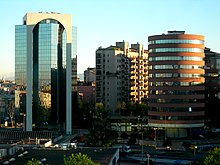
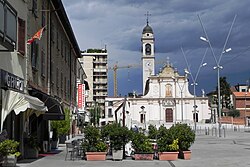
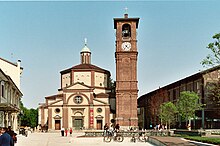




The most-populous municipalities within the Metropolitan City are:
| Rank | City | Population | Area (km2) |
Density (inhabitants/km2) |
Altitude (mslm) |
|---|---|---|---|---|---|
| 1st | Milan | 1,395,274 | 181.76 | 7355.2 | 122 |
| 2nd | Sesto San Giovanni | 81,750 | 11.74 | 6963.4 | 140 |
| 3rd | Cinisello Balsamo | 74,536 | 12.7 | 5869 | 154 |
| 4th | Legnano | 60,259 | 17.72 | 3357.3 | 199 |
| 5th | Rho | 51,033 | 22.32 | 2286.4 | 158 |
| 6th | Paderno Dugnano | 47,118 | 14.1 | 3386.5 | 163 |
| 7th | Cologno Monzese | 46,707 | 8.46 | 5659.6 | 134 |
| 8th | Rozzano | 41,581 | 13.01 | 3196.1 | 103 |
| 9th | San Giuliano Milanese | 37,235 | 30.71 | 1212.5 | 98 |
| 10th | Segrate | 36,911 | 17.5 | 1205.9 | 115 |
| 11th | Bollate | 36,204 | 13.1 | 2106.4 | 156 |
| 12th | Pioltello | 36,061 | 13.1 | 2102.9 | 122 |
| 13th | Cernusco sul Naviglio | 34,848 | 13.2 | 1997 | 134 |
| 14th | Corsico | 34,373 | 5.4 | 11875.6 | 115 |
| 15th | Abbiategrasso | 32,425 | 47.8 | 142 | 120 |
The full list is:
- Abbiategrasso
- Albairate
- Arconate
- Arese
- Arluno
- Assago
- Baranzate
- Bareggio
- Basiano
- Basiglio
- Bellinzago Lombardo
- Bernate Ticino
- Besate
- Binasco
- Boffalora sopra Ticino
- Bollate
- Bresso
- Bubbiano
- Buccinasco
- Buscate
- Bussero
- Busto Garolfo
- Calvignasco
- Cambiago
- Canegrate
- Carpiano
- Carugate
- Casarile
- Casorezzo
- Cassano d'Adda
- Cassina de' Pecchi
- Cassinetta di Lugagnano
- Castano Primo
- Cernusco sul Naviglio
- Cerro Maggiore
- Cerro al Lambro
- Cesano Boscone
- Cesate
- Cinisello Balsamo
- Cisliano
- Cologno Monzese
- Colturano
- Corbetta
- Cormano
- Cornaredo
- Corsico
- Cuggiono
- Cusago
- Cusano Milanino
- Dairago
- Dresano
- Gaggiano
- Garbagnate Milanese
- Gessate
- Gorgonzola
- Grezzago
- Gudo Visconti
- Inveruno
- Inzago
- Lacchiarella
- Lainate
- Legnano
- Liscate
- Locate di Triulzi
- Magenta
- Magnago
- Marcallo con Casone
- Masate
- Mediglia
- Melegnano
- Melzo
- Mesero
- Milan
- Morimondo
- Motta Visconti
- Nerviano
- Nosate
- Novate Milanese
- Noviglio
- Opera
- Ossona
- Ozzero
- Paderno Dugnano
- Pantigliate
- Parabiago
- Paullo
- Pero
- Peschiera Borromeo
- Pessano con Bornago
- Pieve Emanuele
- Pioltello
- Pogliano Milanese
- Pozzo d'Adda
- Pozzuolo Martesana
- Pregnana Milanese
- Rescaldina
- Rho
- Robecchetto con Induno
- Robecco sul Naviglio
- Rodano
- Rosate
- Rozzano
- San Colombano al Lambro
- San Donato Milanese
- San Giorgio su Legnano
- San Giuliano Milanese
- San Vittore Olona
- San Zenone al Lambro
- Santo Stefano Ticino
- Sedriano
- Segrate
- Senago
- Sesto San Giovanni
- Settala
- Settimo Milanese
- Solaro
- Trezzano Rosa
- Trezzano sul Naviglio
- Trezzo sull'Adda
- Tribiano
- Truccazzano
- Turbigo
- Vanzaghello
- Vanzago
- Vaprio d'Adda
- Vermezzo con Zelo
- Vernate
- Vignate
- Villa Cortese
- Vimodrone
- Vittuone
- Vizzolo Predabissi
- Zibido San Giacomo
Municipal government

Here is a list of the municipal government in cities and towns with more than 15,000 inhabitants:
| Municipality | Mayor | Party | Executive | Term | |
|---|---|---|---|---|---|
| Milan | Giuseppe Sala | Ind | PD • EV • A • IV | 2021–2026 | |
| Sesto San Giovanni | Roberto Di Stefano | LN | FI • LN • FdI | 2022–2027 | |
| Cinisello Balsamo | Giacomo Giovanni Ghilardi | LN | FI • LN • FdI | 2023–2028 | |
| Legnano | Lorenzo Radice | PD | PD • Ind | 2020–2025 | |
| Rho | Andrea Orlandi | PD | PD • Ind | 2021–2026 | |
| Paderno Dugnano | Anna Varisco | PD | PD • SI | 2024–2029 | |
| Cologno Monzese | Stefano Zanelli | PD | PD • M5S • AVS | 2023–2028 | |
| Rozzano | Giovanni Ferretti De Luca | LN | FI • LN • FdI | 2024–2029 | |
| San Giuliano Milanese | Giacomo Giovanni Ghilardi | FI | FI • LN • FdI | 2021–2026 | |
| Segrate | Paolo Micheli | PD | PD • Ind | 2020–2025 | |
| Bollate | Franco Vassallo | PD | PD • SI | 2020–2025 | |
| Pioltello | Ivonne Cosciotti | PD | PD • Ind | 2021–2026 | |
| Cernusco sul Naviglio | Ermanno Zacchetti | PD | PD • Ind | 2022–2027 | |
| Corsico | Stefano Martino Ventura | PD | PD • Ind | 2020–2025 | |
| Abbiategrasso | Francesco Cesare Nai | Ind | FI • LN • FdI | 2022–2027 |
Transport
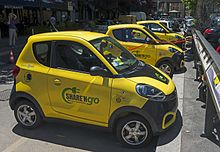
Milan is one of the key transport nodes of Italy and southern Europe. Its central railway station is Italy's second, after Rome Termini railway station, and Europe's eighth busiest.[7][8] The Malpensa, Linate and Orio al Serio airports serve the Greater Milan, the largest metropolitan area in Italy.
Azienda Trasporti Milanesi (ATM) is the Milanese municipal transport company; it operates 5 metro lines, 18 tram lines, 131 bus lines, 4 trolleybus lines and 1 people mover line, carrying about 776 million passengers in 2018.[9] Overall the network covers nearly 1,500 km (932 mi) reaching 46 municipalities.[10] Besides public transport, ATM manages the interchange parking lots and other transport services including bike sharing and carsharing systems.[11]
Cycling

The bicycle is becoming an increasingly important mode of transportation in Milan. Since 2008, the implementation of a city-wide network of bike paths has been initiated, to fight congestion and air pollution. During the COVID pandemic in 2019, 35 km of bike lanes were realized on short notice, to relieve pressure on the subway occupation.[12]
The bike sharing system BikeMi has been deployed in almost all the city and enjoys increasing popularity. Stationless commercial bike and scooter sharing systems are widely available.
Rail
Underground

The Milan Metro is the rapid transit system serving the city and surrounding municipalities. The network consists of 5 lines (M1, M2, M3, M4 and M5), with a total network length of 104 kilometres (65 mi), and a total of 121 stations, mostly underground.[14] It has a daily ridership of 1.15 million,[15] the largest in Italy as well as one of the largest in Europe.
The architectural project of the Milan Metro, created by Franco Albini and Franca Helg, and the signs, designed by Bob Noorda, received the Compasso d'Oro award in 1964.[16] Within the European Union it is the seventh-largest network in terms of kilometres.[17]
Suburban
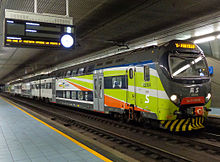
As of May 2023[update], the Milan suburban railway service, operated by Trenord, comprises 11 S lines connecting the metropolitan area with the city centre, with possible transfers to all the metro lines. Most S lines run through the Milan Passerby Railway, commonly referred to as "il Passante" and served by double-decker trains every 4/8 minutes in the central underground section.[18] The system comprises 12 lines serving 124 stations, for a total length of 403 km.[19] There are 415 trains per day with a daily ridership of about 230,000.[20] The service timetable is based on a clock-face scheduling. Although operated by different companies, the Milan Metro and the suburban rail service have integrated tickets.
National and international trains

Milan Central station, with 110 million passengers per year, is the largest and eighth-busiest railway station in Europe and the second busiest in Italy after Roma Termini.[7] Milano Centrale railway station is the largest railway station in Europe by volume.[21] Milano Cadorna and Milano Porta Garibaldi stations are, respectively, the seventh- and the eleventh-busiest stations in Italy.[7] Since the end of 2009, two high-speed train lines link Milan to Rome, Naples and Turin, considerably shortening travel times with other major cities in Italy. Further high-speed lines are under construction towards Genoa and Verona. Milan is served by direct international trains to Nice, Marseille, Lyon, Paris, Lugano, Geneva, Bern, Basel, Zurich and Frankfurt, and by overnight sleeper services to Munich and Vienna (ÖBB).[22] Overnight services to Paris were suspended in 2020 following the COVID lockdown and subsequently discontinued.[23][24]
Milan is also the core of Lombardy's regional train network. Regional trains were operated on two different systems by LeNord (departing from Milano Cadorna) and Trenitalia (departing from Milan Centrale and Milano Porta Garibaldi). Since 2011 Trenord, has operated both Trenitalia and LeNord regional trains in Lombardy, carrying over 750,000 passengers on more than 50 routes every day.[25][26]
Buses and trams

The city tram network consists of approximately 160 kilometres (99 mi) of track and 18 lines, and is Europe's most advanced light rail system.[28] Bus lines cover over 1,070 km (665 mi). Milan also has taxi services operated by private companies and licensed by the City Council of Milan. The city is also a key node for the national road network, being served by all the major highways of Northern Italy. Numerous long-distance bus lines link Milan with many other cities and towns in Lombardy and throughout Italy.[29]
Airports
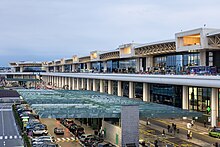

In the surroundings of Milan there are three airports dedicated to normal civilian traffic (Milan Malpensa Airport and Milan Linate Airport, managed by SEA, and Milan Bergamo Airport by SACBO).
Overall, the Milan airport system handles traffic of over 51.4 million passengers and around 700,000 tons of goods every year and is the first in Italy in terms of passenger volume and cargo volume (the second Italian airport system is Rome with 44.4 million passengers in 2023).[30] The Milan Malpensa airport, with over 700 thousand tons, confirms the national leadership, processing 70% of the country's air cargo.[31]
- The intercontinental hub of Milan Malpensa Airport (MXP) is Italy's second-busiest airport, after Rome Fiumicino Airport, with 24.1 million passengers served in 2023 and Italy's busiest for freight and cargo, handling about 700,000 tons of international freight in 2022. Malpensa Airport is the largest international airport in northern Italy, serving Lombardy, Piedmont and Liguria, as well as the Swiss Canton of Ticino. The airport is located 49 kilometres (30 mi) north-west of Milan,[32] in the province of Varese next to the Ticino river dividing Lombardy and Piedmont. Malpensa airport is 9th in the world and 6th in Europe for the number of countries served with direct scheduled flights[33] It is connected to Milan by the Malpensa Express railway service and by various bus lines.[34] The airport is located inside the Parco naturale lombardo della Valle del Ticino, a nature reserve included by UNESCO in the World Network of Biosphere Reserves.[35][36]
- Milan Linate Airport (LIN) is Milan's city airport, less than 8 kilometres (5 mi) from central Milan, and is mainly used for domestic and short-haul international flights. It served 8.6 million passengers in 2023 ranking as the 8th airport in Italy for passenger traffic.[37] Linate Airport is hub of ITA Airways together with Rome Fiumicino Airport and is connected the centre of Milan via the M4 blue metro line.
- Milan Bergamo Airport (BGY) is mainly used for low-cost, charter and cargo flights.[38] The airport is located in Orio al Serio, 3.7 km (2.3 mi) south-east of Bergamo and 45 km (28 mi) north-east of Milan. It is one of Ryanair's three main operating bases, along with Dublin Airport and London Stansted Airport.[39] It served 14.7 million passengers in 2023.[40] A bus service operated by ATB connects to the airport, about 10 minutes from the Bergamo railway station.[41]
Lastly, Bresso Airfield is a general aviation airport, operated by Aero Club Milano.[42] Since 1960 the airport mostly serves as a general aviation airfield for flying club activity, touristic flights and air taxi.[43] It also hosts a base of the state helicopter emergency service Elisoccorso.[44]
-
Map of Milan Metro and suburban railway service.
See also
References
- ^ "Gross domestic product (GDP) at current market prices by metropolitan regions". ec.europa.eu.
- ^ "Codici delle città metropolitane al 1° gennaio 2017". www.istat.it (in Italian). 23 December 2016.
- ^ "Milan, Italy's Industrial and Financial Capital". 18 May 2018. Archived from the original on 7 July 2022. Retrieved 27 May 2022.
- ^ Vittorio Ferri (2009). "Metropolitan cities in Italy. An institution of federalism" (PDF). University of Milan-Bicocca. Retrieved 23 May 2011.
{{cite journal}}: Cite journal requires|journal=(help)[dead link] - ^ a b "LEGGE 7 aprile 2014, n. 56" (PDF). ponmetro.it/. Pon Metro. Retrieved 13 August 2019.
- ^ Metropolitan City of Milan - Electoral services.
- ^ a b c "List of major railway stations in Italy with passenger figures". Ferrovie dello Stato. Archived from the original on 22 July 2011. Retrieved 20 September 2011.
- ^ "Milano Centrale station official page on Ferrovie dello stato website". Ferrovie dello Stato. Archived from the original on 24 September 2011. Retrieved 20 September 2011.
- ^ "ATM in Figures ATM, Azienda Trasporti Milanesi". www.atm.it. Archived from the original on 28 December 2017. Retrieved 10 June 2020.
- ^ "ATM in Figures". www.atm.it. Azienda Trasporti Milanesi. Archived from the original on 28 December 2017. Retrieved 27 December 2017.
- ^ "Carta della Mobilità 2011" (PDF). Azienda Trasporti Milanesi. Archived from the original (PDF) on 29 March 2012. Retrieved 20 September 2011.
- ^ "La mappa delle piste ciclabili di Milano e 35 chilometri di nuovi itinerari: obiettivo raggiunto a ottobre". mentelocale.it (in Italian). 28 August 2020. Archived from the original on 5 November 2021. Retrieved 5 November 2021.
- ^ "Effetto M4: la metro di Milano entra nella top europea" (in Italian). Retrieved 12 October 2024.
- ^ "L'opera che ha fatto di Milano una grande metropoli" [The work that has made a great metropolis of Milan] (in Italian). Metropolitane Milanesi SpA. Archived from the original on 13 October 2018. Retrieved 20 June 2015.
- ^ "Atm, un piano da 524 milioni per 500mila passeggeri un più". la Repubblica. 3 September 2013. Archived from the original on 12 May 2019. Retrieved 23 September 2013.
- ^ "Compasso d'oro 1964 alla Metropolitana di Milano – Motivazione e foto storiche della premiazione" (in Italian). Archived from the original on 10 January 2015. Retrieved 14 February 2024.
- ^ "Metropolitana Milano – Scopri la metropolitana di Milano" (in Italian). Retrieved 31 January 2020.
- ^ "The Lines▶Regional & Suburban Railway". Trenord. Archived from the original on 3 January 2018. Retrieved 27 December 2017.
- ^ "Suburban and Urban routes". Trenord.it. Retrieved 4 December 2023.
- ^ "Passante, Farisè: "Passeggeri +150%. Ora una Circle Line per Milano"" (in Italian). Affari Italiani. Retrieved 28 February 2018.
- ^ "La Stazione Centrale di Milano: la più grande in Europa". 8 February 2020. Archived from the original on 23 September 2023. Retrieved 1 October 2023.
- ^ "International Destinations". Ferrovie dello Stato. Archived from the original on 11 January 2015. Retrieved 20 September 2011.
- ^ "Paris to Venice in a day from €49". The Man in Seat Sixty-One. Retrieved 25 November 2023.
- ^ "Thello operates final trains". International Railway Journal. 30 June 2021. Retrieved 25 November 2023.
- ^ "Lombardia regional operator Trenord launched with €250m train tender". Railway Gazette International. 4 May 2011. Archived from the original on 28 December 2017. Retrieved 27 December 2017.
- ^ "Trenord – Company profile". trenord.it. Archived from the original on 30 January 2019. Retrieved 30 January 2019.
- ^ "Perché a San Francisco girano (anche) i tram di Milano" (in Italian). Retrieved 25 October 2024.
- ^ "world.nycsubway.org/Europe/Italy/Milan (Urban Trams)". World.nycsubway.org. 8 December 2003. Archived from the original on 9 March 2009. Retrieved 13 March 2009.
- ^ "Long-Distance Buses". City of Milan. Archived from the original on 15 July 2016. Retrieved 23 July 2016.
- ^ "Statistiche Dati di Traffico Aeroportuale Italiano" (in Italian). Assareoporti. Retrieved 1 February 2024.
- ^ "Aeroporti italiani: nel 2022 passeggeri in crescita, gli scali del Sud e delle Isole guidano la ripresa del traffico verso i livelli pre-Covid". Assaeroporti (in Italian). 31 January 2023. Archived from the original on 21 February 2023. Retrieved 21 February 2023.
- ^ "EAD Basic". Ead.eurocontrol.int. Archived from the original on 5 October 2013. Retrieved 7 November 2010.
- ^ Ceresa, Gabriele (15 February 2023). "Malpensa torna tra i primi 10 aeroporti al mondo per Paesi serviti con voli diretti". MALPENSA24 (in Italian). Archived from the original on 22 February 2023. Retrieved 22 February 2023.
- ^ "Collegamento Milano Malpensa – Malpensa Express". Malpensaexpress.it. Archived from the original on 18 October 2011. Retrieved 7 November 2010.
- ^ Parco del Ticino. "Turismo sostenibile". ente.parcoticino.it (in Italian). Parco Lombardo Valle del Ticino. Retrieved 8 July 2024.
- ^ Unesco. "Ticino, Val Grande Verbano". unesco.org. Unesco. Retrieved 7 July 2024.
- ^ "Statistiche Dati di Traffico Aeroportuale Italiano". Assaeroporti (in Italian). Archived from the original on 8 December 2013. Retrieved 22 February 2023.
- ^ "Aeroporto di Bergamo – Orio al Serio" (in Italian). Retrieved 3 February 2024.
- ^ "Ryanair". www.ryanair.com. Retrieved 9 January 2024.
- ^ "Real time flights". milanbergamoairport.it. Archived from the original on 30 November 2020. Retrieved 30 January 2019.
- ^ "Train SACBO". Archived from the original on 29 September 2017. Retrieved 25 October 2015.
- ^ "The airport: technical information". Aero Club Milano. Archived from the original on 30 December 2017. Retrieved 29 December 2017.
- ^ "Aero Club Milano" (in Italian). Retrieved 9 February 2024.
- ^ "Base di elisoccorso Milano | HEMS Association" (in Italian). Retrieved 9 February 2024.
External links
![]() Media related to Metropolitan city of Milan at Wikimedia Commons
Media related to Metropolitan city of Milan at Wikimedia Commons




